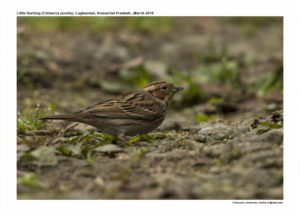
Little Bunting Emberiza pusilla
Etymology:
- Emberiza : Old German name Embritz for a bunting
- Pusilla : Latin word for “ Little”
Vernacular names : Cachar: Dao miji, Guj: Nano gandam
Distribution in India: Winter visitor in Himalayas and North east India
Description: Size of 12-13 cm. It has a heavily streaked brown back and white underparts with fine dark streaking. With its chestnut face and white malar stripe, it resembles a small female reed bunting, but has black crown stripes, a white eye-ring, and a fine dark border to the rear of its chestnut cheeks. The sexes are similar.
Habitat:It is found in open coniferous woodland, often with some birch or willow and stubble grass fields
Food Habits: It eats small grass seeds of various kinds, including fallen grains and some weed seeds. Sometimes small insects during breeding. It forages on ground and at low levels in bushes and trees. Solitary and in pairs and small groups. Outside breeding season usually in small flocks of up to a dozen or so individuals, occasionally more; mixes with other seed-eaters
Breeding Habits: They breed in June-Aug. Nest is built entirely by female, composed of grass, twigs, stalks, moss and hair, lined with fine grass, lichens and hair, placed on ground and concealed in grass tussock, occasionally on tree stump or low down in tree. Clutch 4–6 eggs, incubation by both sexes, period 11–12 days; chicks fed by both sexes, Its natural food consists of insects when feeding young for easier digestion for chicks and water content in the worms supply the chicks with their water requirements. Also the protein helps them grow faster. The chicks leave nest 6–8 days after hatching, still unable to fly, fully fledged 3–5 days later; fed by both parents.